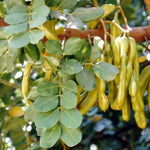Subscribe and save 10%!

Carob / Locust Bean (Ceratonia siliqua)
40 SEK
Unit price perExpected delivery date: 12 January to 19 January.
Applies to orders within Sweden. For other countries - see our delivery terms .
Out of stock
Meddela mig när produkten finns i lager:
Share
SEEDS (15pcs/bag)
Trivial name: Carob, St. John's Bread, Locust Bean, Keration
Scientific name: Ceratonia siliqua
Family: Fabaceae
Plant history & use:
Carob is an evergreen culturally significant plant with a long history of various uses. Already thousands of years ago, Carob - as the dried bean pods are called - were used as a counterweight when weighing gold and precious stones. The kernels (seeds) inside the pod always weighed 0.2 grams and that is where the measurement carat comes from.
Carob has also been used as a cough medicine and sold as candy in pharmacies in the past. The pods have a natural sugar content of 30-50% and this is believed to be one of the reasons why they were eaten as a snack in Ancient Rome.
A known area of use today is as a substitute for cocoa, in roasted and ground form. Unlike cocoa, carob is free from i.a. caffeine and theobromine.
Another common use today is the so called Locust Bean gum extracted from the seeds. Locust Bean gum is a thickener used in different foods, among others: ice cream and crème fraîche.
Carob contains many different vitamins, e.g. vitamins A and B2 and has a taste reminiscent of caramel.
Cultivation:
In its natural environment around the Mediterranean, the Carob tree grows to 10–15 meters and produces pods up to 25cm long.
In the most favored areas of Northern Europe, such as Cornwall, England, the Carob tree is reported being able to grow and overwinter outdoors. In the rest of Europe, it is best grown in pots that are outdoors during the summer and overwintered indoors.
However, the microclimate may vary in one and the same region. The main point to consider should be that the Carob tree can withstand subzero temperatures down to about -8 ºC before the tree takes damage - if you can provide such conditions above that limit it is theoretically possible for the Carob tree to grow outdoors all year round. But it should be considered an experiment in itself and it's recommended to perform it when the tree has gained somewhat growth.
Other than that, the Carob tree is drought tolerant and thrives in well-drained/rocky soil in sunny locations. Avoid damp environments and heavy clay soils. Let the soil dry up between waterings and add nutrients during the summer months if desired.
Transplanting to a larger pot is preferably done before the taproot (the thickest main root) has grown down to the bottom. As with all plants, restricted space for taproot growth is significantly decreasing growth rate of the entire plant.
Carob trees growing in their natural environment, the Mediterranean Basin, are high-producing trees capable of yielding 400 kilos of bean pods each year.
Sowing:
Soak the seeds in lukewarm water for 3 days before sowing. Sow in sowing soil. Cover with 2 cm of soil. Keep the soil moist. Germination time is about 2-5 weeks and optimal germination temperature is 22-26 ºC.
Characteristics:
Lifespan: Perennial
Location: Sun
Height: up to 15 m
Germination Time: 2-5 weeks
USDA Zone: 9-11
- Choosing a selection results in a full page refresh.
- Opens in a new window.








